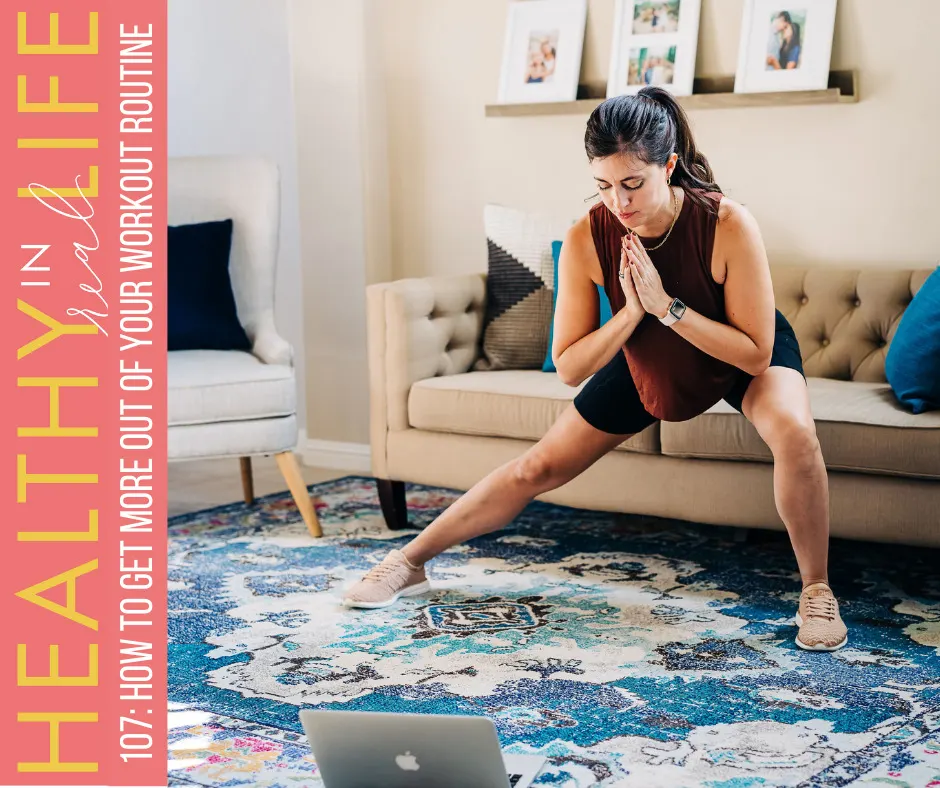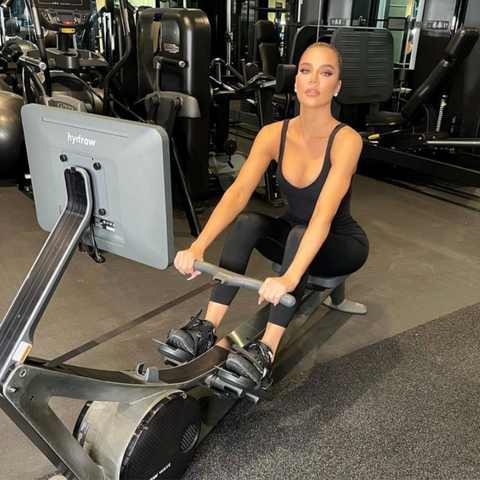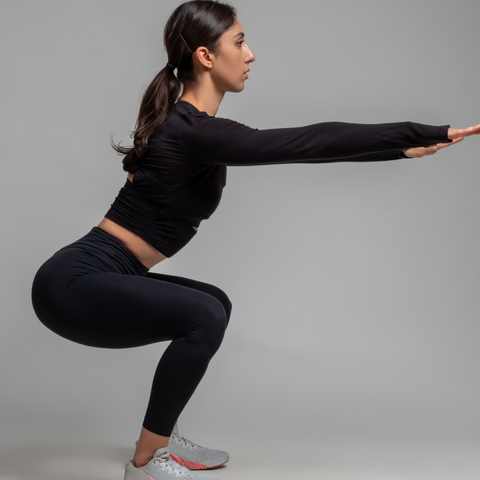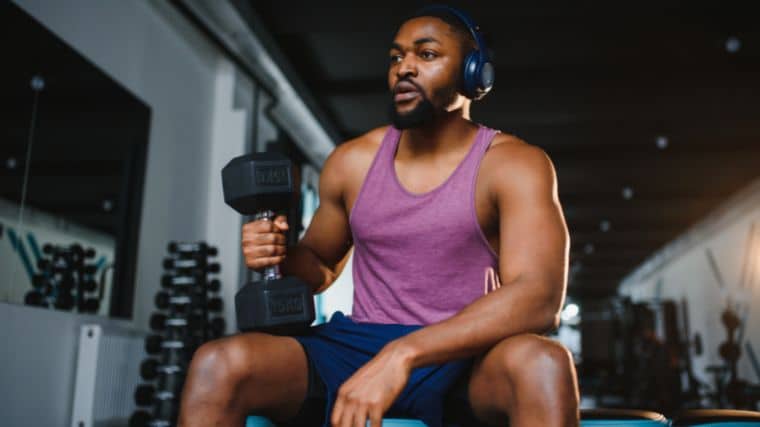We spend a large part of our day at work, eight or more hours five days per week. If our job requires us to sit while performing our daily tasks, that is a lot of sitting. But what are we supposed to do? Only some people can or want to work a labor-intensive job. For everyone else, there are desk exercises and workouts.
Yes, you read that correctly. Incorporating simple exercises, you can do at your desk can help mitigate the damage of sitting all day. If you are wondering how this is possible, read on.
Table of Contents:
- What are desk exercises?
- What are the benefits of desk exercises?
- Why you should incorporate desk exercises
- How much should you exercise if you have a desk job?
- 9 best exercises at your desk
- 4 stretches you can do at your desk
- 8 desk workouts to incorporate in your work days
- Easy tips for getting more exercise at work
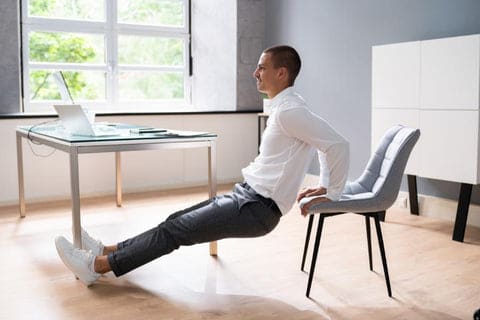
What are desk exercises?
Desk exercises are variations of movements you can perform using a desk or chair. Most desk exercises are basic bodyweight movements you can easily incorporate throughout the day to provide more exercise. For people with relatively sedentary jobs, getting a little extra exercise during the day can make a big difference.
What are the benefits of desk exercises?
As fitness folks, we often think an hour in the gym a few days per week is enough activity to cancel out any other bad habits we may have. However, sitting all day can’t be fixed with exercise alone.
A 2015 meta-analysis examined the association between sedentary time and disease and found “prolonged sedentary time was independently associated with deleterious health outcomes regardless of physical activity”1.
Based on this, the adverse effects of sitting all day can at least cut into the benefits of spending time in the gym. The good news is, adding some activity to your day can significantly benefit your health if you work a sedentary desk job.
Desk exercises are one convenient way to help get those with desk jobs up and moving periodically throughout the day. It doesn’t have to be anything that takes up much time, either. A few minutes a couple of times per day can be enough.
Another way to mitigate the damage of having a desk job is to switch to a standing desk. In recent years, many companies have allowed employees to use standing desks. However, if you can’t get new furniture for your office, you can put a box on your desk to raise the height and allow you to create a standing workstation.
Research shows standing burns roughly 0.15 calories more per minute compared to sitting2. This equates to an extra 60-80 calories burned daily for the average person. Of course, this is not huge, but it can add up over time.
In addition to burning more calories, a standing desk promotes more movement. When standing, you can shift from side to side, taking turns balancing on both legs and one leg at a time. Taking short movement breaks is also easier since you are already on your feet.
If you are not ready for a standing desk, don’t worry. Performing the desk exercises in this article will get you moving in the right direction.
Why You Should Incorporate Desk Exercises:
Sedentary behavior can cause a wide range of adverse health outcomes. Obesity, diabetes, chronic pain, and the list goes on.
Prolonged sitting can even affect how well we perform in the gym. It’s common for our muscles to become tight and immobile when sitting for long periods—being stuck in a compromised position, as sitting does, causes tight hips, low back pain, and shoulder mobility issues. It’s hard to exercise effectively with a poorly functioning body.
And, the problem is, we don’t just sit while at work. We sit in the car to and from work while eating meals, scrolling on our phones, and watching TV at night. When you add this up, it’s easy to comprehend how most Americans spend twelve or more hours per day seated.
Anything we can do to break up how long we sit during the day will be beneficial.
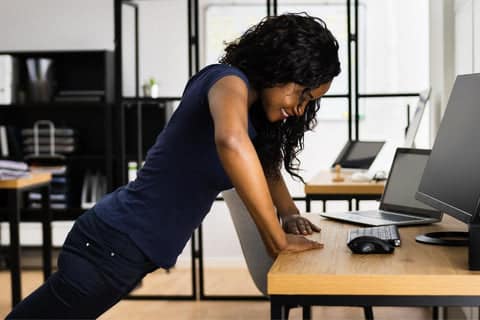
How much should you exercise if you have a desk job?
NEAT stands for non-exercise activity thermogenesis, the calories used for everything that is not sleeping, eating, or exercising. Occupation plays a significant factor in NEAT. People who work active jobs can burn over 1,000 more calories per day than a desk job employee simply from NEAT3.
If you have a desk job, you must compensate for the lack of activity. Start by exercising in the gym at least three times per week. However, more is needed to make up for sitting all day.
At the minimum, break up your day, and walk around the office every 60 minutes. It doesn’t have to be a lot, but walking around for a few minutes every hour will go a long way.
In addition, do one to two mini-workouts and one longer desk workout each day. The goal is to avoid getting sore or doing anything that would take much recovery time because these are extra workouts. We don’t want to impact our regular gym training negatively.
9 Best Exercises At Your Desk:
Here are nine exercises you can do right at your desk.
1. Desk Pushup:
The pushup is one of the most fundamental bodyweight exercises and can be a valuable tool for getting in extra activity at your desk. Drop down and push out a few reps anytime you have a few spare minutes throughout the day. If you struggle to do a standard pushup, give hand-elevated pushups a try. These are pushups with your upper body elevated by placing your hands on a desk or office chair. As the desk push ups become easier, progressively lower the hand elevation until you can start from the floor.
Instructions:
- Place your hands on your desk or chair shoulder-width apart. Start with your arms fully extended and your legs straight. Your body should form a straight line.
- To begin the movement, lower yourself by bending the elbows and allowing your shoulders to move until your chest almost touches the floor, making sure to keep your core tight.
- Once you get close to the floor, push up with your arms, lifting your upper body back to the starting position. Repeat for the desired amount of reps.
2. Chair Squat:
The body weight squat is the most basic fundamental movement. It’s an exercise that reinforces the squat movement pattern and can also be a great workout. You can bang out reps right at your desk. A good habit to get into is performing five to ten reps anytime you get up from your office chair. If you struggle to reach depth when air squatting, try sitting on your chair. Perform chair squats until you feel comfortable squatting without the chair. The key is not to relax while sitting on the chair. Make sure you maintain tension in the core and lower body.
Instructions:
- Start in a standing position with your feet shoulder width apart.
- Drop your hips down and back while simultaneously bending your knees. Continue moving down until your hips are below the tops of your knees or you touch the chair.
- Once you reach the bottom position, maintain a vertical torso and stand back up. To help with balance, extend your arms directly out in front of you during the movement.
3. Chair Dip:
The chair dip is a great triceps exercise you can do right at your desk. It’s also a great transition into eventually doing regular parallel bar dips. Instead of using a chair, you can put your hands on something higher, like your desk, which will allow you to support less of your body weight.
Instructions:
- For the chair dip, you will need to stand in front of a chair while facing away from it.
- Start by holding on to the chair on its edge with the arms fully extended, separated at about shoulder width. Extend the legs forward, bent at the waist and perpendicular to your torso.
- To begin the movement, slowly lower your body by bending the elbows. Go down as far as you comfortably can. The more extensive range of motion you use, the better. Keep your hips from shifting away from the chair.
- From there, press your torso using your triceps until you reach the starting position. Keep your hips as close as possible by keeping your torso upright.
4. Single Leg Calf Raise:
Out of all of the muscle groups in the body, the calves get ignored more than any other. Neglecting the calves is a mistake. Not only do muscular calves look great, but they are also crucial for athleticism and are highly functional. Anyone who has walked up a big hill or carried a heavy box up a few flights of stairs will agree. The best part of the single-leg calf raise is that you can do it anywhere, even at your desk.
Instructions:
- Start by grabbing the back of your chair or desk for support.
- Lift one leg off the floor, causing your entire body weight to be supported on the other leg.
- Keep your working leg straight and raise your heel off the ground, lifting your entire body weight as you do so.
- Use a slow tempo, pausing at the top before returning your heel to the ground. After you complete all the reps on one leg, switch legs and repeat.
5. Chair Mountain Climbers:
The mountain climber is a very underrated calisthenic that activates many muscles and increases the heart rate. Instead of starting in a pushup position on the floor, you can elevate your hands on your chair (or desk). Raising your hands allows you to perform the movement without supporting as much of your body weight. Other than the different hand placement, perform the exercise the same way.
Instructions:
- Stand away from your chair, lean forward, and place your hands on the chair. Make sure to distribute your weight evenly between your hands and your toes.
- Your hands should be roughly shoulder-width, back flat, core engaged, and head in alignment.
- Bring your right knee under your chest as far as possible to start the movement. Then, in one motion, pull the right knee back and get the left knee under your chest.
- Keeping your hips down, “run” your knees in and out while maintaining control for the desired reps.
6. Seated Bicycle Crunch:
Bicycle crunches are one of the most common abdominal exercises, and for a good reason. Although the movement is known for being a fantastic oblique exercise, they target your entire core. Plus, you can do them while seated in a chair.
Instructions:
- Sit toward the front of your chair, giving yourself room to lean back. Place your hands behind your head and flare the elbows to the sides. Bend your knees to around 90 degrees with your feet off the floor.
- Move your shoulders across the body in a crunch while simultaneously using a bicycle pedal motion to kick forward with the right leg and retract the left knee. Bring your right elbow toward your opposite knee by crunching to the side.
- Crunch to the opposite side as you cycle your legs and this time, bring your left elbow to your right knee.
- Continue alternating until you’ve completed the recommended repetitions for each side.
7. Desk Plank:
The plank is an isometric exercise, meaning it doesn’t require movement. However, don’t let the simplicity of this exercise confuse you. This exercise is very effective. The plank is an excellent exercise to improve core stability and prevent low back pain. Since it doesn’t require any movement, it’s one of the safest core exercises you can do if done correctly.
Instructions:
- Stand away from your desk, lean forward, and place your forearms on the edge of the desk. Make sure to distribute your weight evenly between your forearms and your toes. The torso should be in a straight line.
- Bend the arms so that your elbows are directly under your shoulders.
- Once in position, brace your core hard like you are preparing to get punched in the stomach. Flex your glutes and thigh muscles as well while continuing to breathe normally.
- Keep your torso and spine neutral at all times, and hold this position for the duration of the set.
8. Desk Exercise Bike:
There are few cardio options while working at a desk chair all day. However, one option is a small exercise bike made to go under your desk. A desk exercise bike is a great way to increase activity while still being productive. Most models are quiet, so you can pedal while on a business call or answering emails.
Instructions:
- Place the exercise bike under your desk.
- Position your chair to allow you to pedal downward to keep the cycle in place and to keep your chair from swiveling.
- When pedaling, focus on keeping your upper body still. Only your legs should be moving.
9. Hand Grippers:
Hand grippers are one of the most effective exercises you can do at your desk. A quality set of hand grippers can help you improve your grip strength and build massive forearms. However, not all grippers are made equal. Look for a heavy-duty set made with all metal and no plastic.
Instructions:
- Place the handle at a 45-degree angle in your palm. The top of the device should be just above the base of your thumb.
- Place your fingers as low on the handle as possible. You can use two hands to position the handles properly.
- Once the gripper is in position, squeeze the handles together until they touch. That is one rep. Finish the set and switch hands.
4 Stretches You Can Do At Your Desk:
In addition to a lack of activity, working at a desk all day can cause tight muscles. Here are four stretches you can do at your desk to stay loose.
1. Seated or Standing Arm Circles:
Arm circles may offer the most significant benefit-to-effort ratio of any exercise. Doing a few arm circles throughout the day won’t turn you into a bodybuilder, but they can help prevent injuries and prepare your shoulders for heavy pressing.
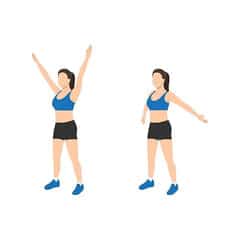
Instructions:
- Sit up tall in your chair and extend your arms parallel to the floor to form a “T.”
- Begin by circling your arms forward using small controlled motions, gradually making the circles bigger until you reach your complete range of motion.
- Reverse the direction of the circles after completing the desired amount of reps.
2. Couch Stretch with Chair:
The couch stretch is excellent for addressing tight quads and hip flexors. As the name implies, you usually use a couch, but it can also be performed with a chair.
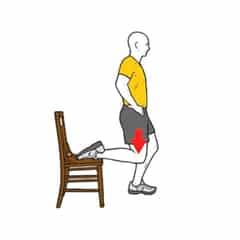
Instructions:
- Begin by getting into a split squat position, with the back knee touching the ground and your heel up toward your glutes.
- The front of your back foot should rest on the chair.
- The knee should be straight with the front edge of the chair. Initiate the stretch by pressing your hip forward. Repeat on the other side.
3. Seated Pigeon Pose:
The pigeon pose is a staple yoga position you can do right in your chair. If you have tight hips, this should be your go-to stretch.
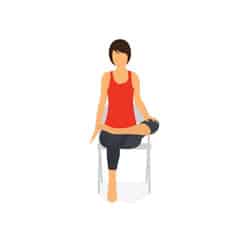
Instructions:
- Sit in a chair with your feet flat on the ground.
- Bring your right knee toward your chest, and rotate it to put your right ankle on the left knee.j
- Once in position, lean forward and bring your upper body closer to your thigh.
- Hold the stretched position for up to 30 seconds.
- Repeat on the other leg.
4. Seated Cat Cow:
The seated cat-cow pose directly targets the poor rounded position most of us are in all day while working on a computer.
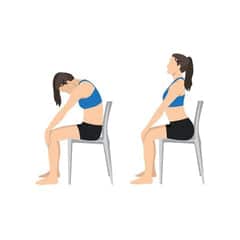
Instructions:
- Sit in a chair with your feet flat on the ground.
- Place your hands on top of your legs, with your palms down.
- Take a deep inhale while arching the back and opening the chest.
- On the exhale, round the upper back, drawing the chin toward the chest.
- Repeat slowly for the desired number of reps.
8 Desk Workouts to Incorporate In Your Work Days:
Before getting into the workouts, it’s essential to mention these are designed to get you moving throughout the day but shouldn’t take the place of a regular training program. These workouts should supplement your typical gym workouts. Think of the following workouts as extra credit or bonus work.
Workout #1: 20-30 minutes of full-body training
- Desk Push-up: 4 sets x 10-12 reps
- Chair Squat: 4 sets x 10-12 reps
- Chair Dip: 3 sets x 10-12 reps
- Single Leg Calf Raise: 3 sets x 12-15 reps
- Spend the remaining amount of time using the hand grippers. Perform five reps, alternating between hands.
Workout #2: 20 minutes of abs
*20 minutes as many rounds as possible
- Seated Bicycle Crunches: 20 reps on each side
- Desk Plank: 30 seconds
- Desk Mountain Climber: 20 reps on each side
Workout #3: 10 minutes of upper body
- Desk Pushup: 3 sets of 10-20 reps
- Chair Dip: 3 sets of 10-20 reps
- Hand Gripper: 3 sets of 5 reps on each hand
Workout #4: 10 minutes of lower body
- Chair Squat: 3 sets of 10-20 reps
- Single Leg Calf Raise: 3 sets x 12-15 reps.
- Spend the remaining time on the desk exercise bike.
Workout #5: 5-minute Grip Workout
- Hand Gripper: 5 sets of 5 reps on each hand (rest as little as possible between sets)
Workout #6: The All-Day Workout
- Pedal on the desk exercise bike anytime throughout the day you can – phone calls, emails, etc.
Workout #7: 50-100 Pushups
- Accumulate 50-100 desk pushups throughout the day. Do 5-10 reps anytime you have a spare minute or two throughout the day.
Workout #8: 50-10 Squats
- Accumulate 50-100 chair squats throughout the day. Do 5-10 reps anytime you have a spare minute or two throughout the day.
Easy Tips For Getting More Exercise at Work:
- Track Daily Steps While at Work: Track how many steps you take during the day. Most smartphones have a step-tracking app built in, so you don’t need to wear a fitness watch or anything like that. Each day shoot for a certain number of steps. A good habit to get into is walking around for a few minutes every half hour.
- Exercise During Lunch Break: If you get an hour for lunch, pack food from home, and eat it quickly while at your desk. Spend the remaining time getting in a quick desk workout.
- Desk Exercise Bike: The easiest way to exercise more at work is to purchase a desk exercise bike. It goes under your desk, and you can pedal throughout the day while working.
- Reduce Optional Sitting: Although this is not a tip to get in more direct exercise, this is a tip to reduce sitting. There are a lot of times throughout the day when we have no option but to sit. I am still looking for a car that allows you to drive while standing up. However, take any opportunity to stand. Become more mindful of optional sitting. If you are sitting down for no reason, stand up.

FAQs about Desk Exercises & Workouts:
How can I exercise at my desk?
Getting in some exercise at your desk is easier than you think. Anytime you have a free minute, bang out a few reps of desk pushups or chair squats. Over the entire day, the repetitions will add up.
Are there exercises you can do while sitting?
You can perform the desk exercise bike and the hand grippers while sitting at your desk without anyone knowing.
What is the best exercise while sitting?
The best cardio exercise while sitting is a desk exercise bike. The best strength exercise while sitting is using hand grippers.
Do desk exercises work?
As with most exercises, desk exercises can work as long as they are challenging enough and done consistently.
How much should you exercise if you have a desk job?
Exercising at your desk should not take the place of standard workouts. However, if you have a desk job, try to get 2-3 mini-exercise breaks throughout the day. Depending on your available time, they can be as short as a minute or as long as thirty minutes.
How can I improve my physical activity with a desk job?
The easiest way to improve your physical activity with a desk job is to get up, walk around every thirty minutes, and perform a couple of mini-workouts throughout the day.
How can I exercise at my desk in secret?
The best way to exercise at your desk in secret is to get a desk exercise bike and use it throughout the day. It goes under your desk and is very quiet, so no one should be able to see or hear it while you use it.
Pro tip: A balance board is a great way to exercise at work too. Check out our favorite balance boards that you can bring to work.

- Biswas A, Oh PI, Faulkner GE, Bajaj RR, Silver MA, Mitchell MS, Alter DA. Sedentary time and its association with risk for disease incidence, mortality, and hospitalization in adults: a systematic review and meta-analysis. Ann Intern Med. 2015 Jan 20. Erratum in: Ann Intern Med. 2015 Sep 1.
- Saeidifard, F., Medina-Inojosa, J. R., Supervia, M., Olson, T. P., Somers, V. K., Erwin, P. J., & Lopez-Jimenez, F. (2018). Differences of energy expenditure while sitting versus standing: A systematic review and meta-analysis. European Journal of Preventive Cardiology.
- Levine JA. Non-exercise activity thermogenesis–liberating the life-force. J Intern Med. 2007 Sep
























